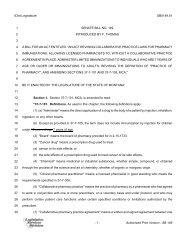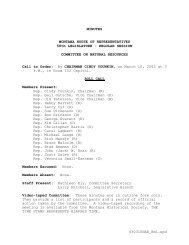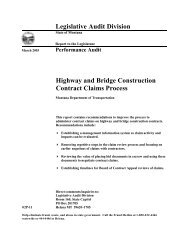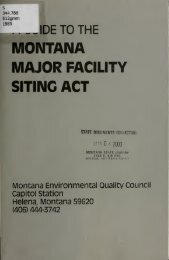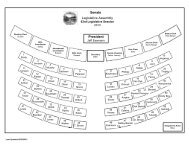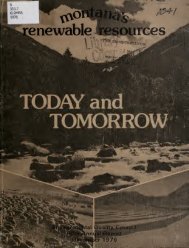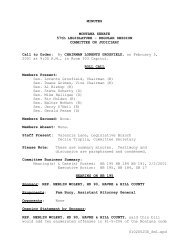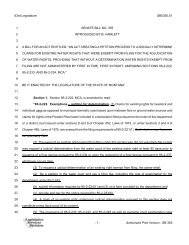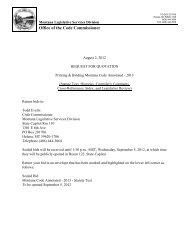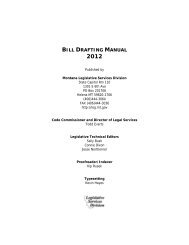Public Comment. Volume III - Montana Legislature
Public Comment. Volume III - Montana Legislature
Public Comment. Volume III - Montana Legislature
You also want an ePaper? Increase the reach of your titles
YUMPU automatically turns print PDFs into web optimized ePapers that Google loves.
Smre v. Higgins, 166 blont. 90, 95, 530 P.2d 776, 779 (1975).<br />
Consequently, it can be argued that the proof required of a protesting party (landowner) in<br />
necessity cases is much stronger than a mere preponderance of the evidence. This is because of the<br />
deference which courts have traditionally shown to decision-making by agencies which possess much<br />
expertise and much discretion, and as required by the separation ofpowers. Mont. Const. Art. 111, fj 1.<br />
In any event, this process, as well as the standards of proof and shifting of the burdens of proof,<br />
has been a part of <strong>Montana</strong> statutory and case law for over 100 years. It has, for the most part, served<br />
the state well in attempting to provide adequate roads and highways for the people of the state, while<br />
protecting private property: To change the standard, as proposed, would not only increase the amount of<br />
proof required, it would destroy the presumption that has existed for over a century. This would mean, in<br />
essence, that the road authorities would no longer be the ultimate designer of the roads. Rather, that task<br />
would be shifted to a significant degree to the Courts, because in every case where a landowner contested<br />
necessity, the Court could not rely on the presumption, and would be asked to decide whether a certain<br />
road design was necessary.<br />
The process and the burdens of proof should be left the way they have been established. That is,<br />
the road designers would be presumed to have done theirjob, unless the landowner can show an abuse<br />
of discretion.<br />
In turn, this shifting of discretion fiom the road designers to the Courts would be very expensive<br />
for the taxpaying public and potentially devastating to the efforts of the public agencies attempting to<br />
upgrade <strong>Montana</strong>'s infrastructure. It would only take one landowner who opposed a ten million dollar<br />
road building project, for example, to contest necessity, and thereby delay amuch needed improvement.<br />
This, in turn, puts peoples lives at risk. Even on less costly projects, a landowner could hold the project<br />
hostage, and make exorbitant monetary demands upon the public's money. these are demqds which the<br />
agencies could well feel compelled to meet, because of the need for the project. There is in the real world<br />
always someone who wants to stop projects for a wide variety of reasons. Both the NEPA and MEPA<br />
processes generally provide citizens a forum to express opinions and offer suggestions regarding a project.<br />
To make the proposed change in the standard of proof would provide yet another forum for these<br />
grievances, with the likely outcome that state's road building program would be crippled, if not halted<br />
altogether.<br />
The standard of "clear and convincing evidence" is somewhat similar to the standard used in<br />
criminal cases. To require such a standard in favor of the person opposing a project would be a drain on<br />
MDTs resources every time it had to convince a Court that the road improvement was necessary. At this<br />
point no one knows what type of proof the new standard would mean. There is no precedent in this<br />
context to look at for guidance. No one knows what type of engineers, or other experts, would have to<br />
take the stand to convince a judge of the necessity. Would MDT be required to put on a wide array of<br />
evidence fiom traffic, design, safety and construction engineers? No one knows how many more lawyers<br />
and engineers MDT would have to hire to shoulder the extra burden. Would the new standard mean that<br />
one person had to die in a car wreck on that stretch of road? Would it mean that a large truck carrying<br />
hazardous waste had to go through a bridge railing into a river or stream before the bridge could be<br />
replaced? Would these circumstances be "clear and convincing evidence?" Nobody knows. The point<br />
is, however, that the people who study and design the roads are the proper parties to make these decisions.<br />
If they abuse that discretion, then the present balance and standards of proof provide an avenue to remedy<br />
EQC Eminent Domain Study -1 15-



